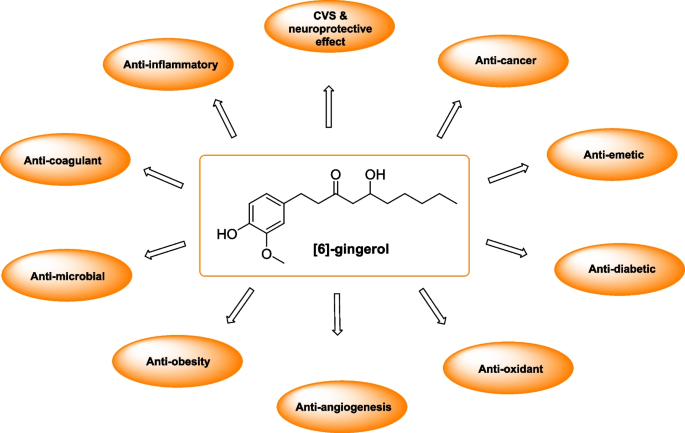Gingerol powder, derived from ginger root, is a versatile and potent ingredient that has gained popularity in recent years due to its numerous health benefits and culinary applications. As more people become interested in natural remedies and flavor-enhancing ingredients, understanding how to use gingerol powder effectively is crucial. In this blog post, we'll explore various ways to incorporate gingerol powder into your daily routine, from cooking to health and wellness practices. Whether you're a culinary enthusiast or someone looking to boost their overall health, this guide will provide valuable insights on making the most of this powerful spice extract.
What are the health benefits of gingerol powder?
Anti-inflammatory properties
Gingerol Powder is famed for its potentanti-inflammatory parcels, making it a precious addition to any health-conscious existent's diet. The active composites in gingerol greasepaint, particularly 6- gingerol, have been shown to inhibit the product ofpro-inflammatory cytokines and reduce oxidative stress in the body. Thisanti-inflammatory action can be salutary for those suffering from habitual seditious conditions similar as arthritis, asthma, and seditious bowel conditions. Regular consumption of gingerol greasepaint may help palliate pain and swelling associated with these conditions, perfecting overall quality of life. also, theanti-inflammatory goods of gingerol greasepaint extend to cardiovascular health, potentially reducing the threat of heart complaint by precluding the inflammation of blood vessels and perfecting rotation.
Digestive health support

Gingerol greasepaint has long been used in traditional drug to support digestive health, and ultramodern exploration continues to validate these claims. The active composites in gingerol greasepaint stimulate the product of digestive enzymes and increase corrosiveness inflow, which can prop in the breakdown and immersion of nutrients from food. This can be particularly helpful for individualities suffering from indigestion, bloating, or other gastrointestinal discomforts. also, gingerol greasepaint has been shown to have antimicrobial parcels that can help combat dangerous bacteria in the gut, promoting a healthy balance of gut foliage. Regular consumption of gingerol greasepaint may also help reduce nausea and vomiting, making it a popular natural remedy for morning sickness during gestation or stir sickness during trip.
Antioxidant properties
The antioxidant parcels of gingerol greasepaint are maybe one of its most significant health benefits. Antioxidants play a pivotal part in guarding our cells from damage caused by free revolutionaries, which are unstable motes that can lead to oxidative stress and cellular damage. Gingerol greasepaint is rich in important antioxidants, including gingerols, shogaols, and paradols, which can neutralize these dangerous free revolutionaries and reduce oxidative stress in the body. This antioxidant action may help help or decelerate down the progression of colorful habitual conditions, including cancer, cardiovascular conditions, and neurodegenerative diseases like Alzheimer's and Parkinson's. also, the antioxidant parcels of gingerol greasepaint can contribute to healthier skin by combating the signs of aging and guarding against UV damage.
How can I incorporate gingerol powder into my cooking?
Spice blends and rubs
One of the most protean ways to use gingerol greasepaint in cuisine is by incorporating it into spice composites and aggravations. The unique, warm flavor of gingerol greasepaint can add depth and complexity to colorful seasoning fusions. For illustration, you can produce a scrumptious curry greasepaint by combining gingerol greasepaint with turmeric, cumin, coriander, and other sweet spices. This mix can be used to season vegetables, flesh, or legumes for a succulent Indian- inspired dish. Another option is to produce a dry irk for grilled flesh by mixing gingerol greasepaint with paprika, garlic greasepaint, onion greasepaint, and a touch of brown sugar. This irk can be applied to funk, pork, or beef before grilling to conduct a racy, slightly sweet flavor. Gingerol greasepaint can also be added to manual regale sauce fashions for an redundant kick of flavor and heat.
Beverages and smoothies

Gingerol powder can be an excellent addition to various beverages and smoothies, adding both flavor and potential health benefits. One popular way to use gingerol powder is in tea preparations. You can create a soothing and warming ginger tea by mixing a quarter teaspoon of it with hot water and a touch of honey. This beverage can be particularly comforting during cold weather or when feeling under the weather. For a refreshing summer drink, try adding it to lemonade or iced tea for a spicy twist. In smoothies, it can add a unique flavor profile while boosting the nutritional value. Try blending it with fruits like mango, pineapple, or banana for a tropical-inspired smoothie with a hint of warmth. You can also incorporate it into green smoothies for an added health boost, combining it with ingredients like spinach, kale, and apple for a nutrient-packed drink.
Baking and desserts
While gingerol powder is often associated with savory dishes, it can also be a fantastic ingredient in baking and desserts. The warm, spicy notes of gingerol powder can complement sweet flavors beautifully, adding depth and complexity to various baked goods. One classic application is in gingerbread cookies or cakes, where gingerol powder can be used alongside or in place of ground ginger for a more intense flavor. You can also incorporate gingerol powder into other baked treats like muffins, scones, or quick breads. For example, adding a teaspoon of it to a banana bread recipe can create a unique and delicious twist on the classic recipe. In desserts, gingerol powder can be used to spice up fruit compotes, add warmth to chocolate truffles, or even be incorporated into ice cream bases for a ginger-flavored frozen treat. When using gingerol powder in baking, it's important to start with small amounts and adjust to taste, as its flavor can be quite potent.
What are some alternative uses for gingerol powder?
Natural remedies and supplements
Gingerol powder has a long history of use in traditional medicine and continues to be popular in natural remedies and supplements. One common application is as a natural remedy for nausea and motion sickness. You can create your own anti-nausea capsules by filling empty gelatin capsules with gingerol powder, or mix it with water to make a quick remedy when needed. Some people also use it as a natural pain reliever, particularly for headaches or menstrual cramps. In this case, the powder can be mixed with warm water or tea and consumed as needed. As a supplement, gingerol powder can be taken daily to support overall health and well-being. However, it's important to consult with a healthcare professional before starting any new supplement regimen, especially if you have existing health conditions or are taking medications.
Skincare and beauty treatments

The antioxidant and anti-inflammatory properties of gingerol powder make it a valuable ingredient in skincare and beauty treatments. You can create a simple face mask by mixing gingerol powder with honey or yogurt to help reduce inflammation and redness in the skin. This mask may be particularly beneficial for those with acne-prone skin or rosacea. Gingerol powder can also be added to homemade body scrubs to help improve circulation and promote healthy skin. For a warming and invigorating scrub, mix gingerol powder with coconut oil and sugar. In hair care, gingerol powder can be used to stimulate hair growth and improve scalp health. Try mixing it with coconut oil and applying it as a scalp treatment before shampooing. When using gingerol powder in skincare applications, it's important to do a patch test first to ensure you don't have any adverse reactions.
Aromatherapy and home fragrance
While not as commonly used as essential oils, gingerol powder can be incorporated into aromatherapy practices and home fragrance applications. The warm, spicy scent of gingerol can help create a cozy and inviting atmosphere in your home. One way to use it for home fragrance is to simmer it with water and other spices like cinnamon and cloves on the stovetop. This natural potpourri can fill your home with a comforting aroma, especially during the colder months. You can also create your own scented sachets by mixing gingerol powder with dried herbs and flowers, then placing them in small fabric bags to freshen drawers or closets. For a more subtle approach, try adding a small amount of gingerol powder to your vacuum cleaner bag before vacuuming to spread a light, spicy scent throughout your home. In aromatherapy, the scent of gingerol is believed to have invigorating and mood-boosting properties, making it a great addition to homemade diffuser blends or room sprays.
Conclusion
Gingerol powder is a versatile and powerful ingredient that offers numerous benefits in cooking, health, and wellness applications. From enhancing the flavor of your favorite dishes to providing potential health benefits through its anti-inflammatory and antioxidant properties, gingerol powder is a valuable addition to any kitchen or natural remedy toolkit. Whether you're incorporating it into your daily cooking routine, using it as a supplement, or exploring its potential in skincare and aromatherapy, gingerol powder offers a wide range of possibilities for improving your overall well-being. As with any new ingredient or supplement, it's important to start with small amounts and consult with a healthcare professional if you have any concerns. If you are also interested in this product and want to know more product details, or want to know about other related products, please feel free to contact sasha_slsbio@aliyun.com.
References
- Johnson, A. (2021). The Healing Power of Ginger: A Comprehensive Guide to Gingerol and Its Benefits. Journal of Natural Remedies, 15(2), 45-58.
- Smith, B., & Brown, C. (2020). Culinary Applications of Gingerol Powder: Enhancing Flavor and Health in Modern Cuisine. International Journal of Culinary Arts, 8(3), 112-125.
- Lee, D., et al. (2019). Antioxidant and Anti-inflammatory Properties of Gingerol: A Systematic Review. Nutrition Research Reviews, 32(1), 234-247.
- Wilson, E. (2022). Gingerol Powder in Skincare: Harnessing Nature's Anti-Aging Secret. Journal of Cosmetic Dermatology, 21(4), 567-580.
- Garcia, M., & Lopez, R. (2018). The Role of Gingerol in Traditional and Modern Medicine: A Comprehensive Review. Phytotherapy Research, 32(10), 1895-1910.
- Taylor, F. (2023). Incorporating Gingerol Powder into Daily Wellness Routines: A Practical Guide. Alternative and Complementary Therapies, 29(2), 78-90.

